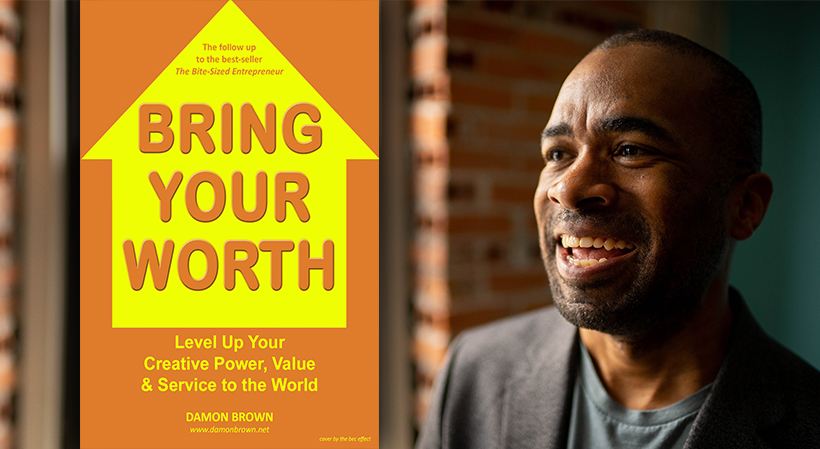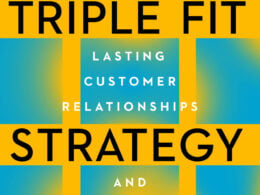Many entrepreneurs and solopreneurs struggle to price their product or service; set the price too high and miss out on sales, or set it to low and risk under-valuing themselves. Author, speaker, coach and entrepreneur Damon Brown serves nontraditional entrepreneurs and creatives, so he knows this conundrum well. He writes a column for Inc.com and authored the popular Bite-Sized Entrepreneur book series.
Brown’s latest book is called “Bring Your Worth: Level Up Your Creative Power, Value & Service in the World.” We caught up with Brown to get his take on setting prices, delivering impact through your business and more.
The following conversation has been edited for clarity and brevity.
StartupNation: Why do you think pricing is so fraught for many entrepreneurs and solopreneurs?
Damon Brown: For many people who are doing things outside of the traditional metrics, whether it’s freelance writers, freelance photographers, entrepreneurs, consultants … all those things don’t have outside metrics.
Often and unfortunately, we often end up defaulting to either what people are able or willing to pay us, or we end up measuring our worth based on how other people perceive us. The second one is more dangerous, because with the first one, you can kind of naturally get momentum and raise your pricing over time because your reputation builds.
The latter, though, is really dangerous, because the value of what we’re doing can change overnight in either direction. Those skill sets that were valuable in the 19th century became virtually obsolete in the 20th century. We’re seeing the same thing as technology changes, suddenly different skill sets become valuable. If you end up leaning on what other people believe, then you might end up missing the boat on something that might be very innovative today, or something that might be really important tomorrow.
Related: Q&A with Author Damon Brown on Bite-Sized Entrepreneur Series
StartupNation: Outside of setting a number, there are lots of different pricing models to consider. How can entrepreneurs and solopreneurs choose between product pricing, subscription pricing, hourly pricing, and so on?
Damon Brown: The first thing is figuring out what works for you. You don’t need to be locked into a particular pricing model. About a year ago, I launched the Bite-Sized Entrepreneur Boot Camp through Teachable. It’s kind of set it and forget it on my end. People can go in there (to access video content) and pay the set fee, so that’s one type of model.
I write for Inc. Magazine online, and their model is based on an advanced version of the pay-per-click model. That’s another type of revenue source. I have six books that I’ve self-published, and those are flat royalties, so when people buy the book directly from me, or if they buy it from Amazon, I’m getting paid.
For me, my security is based on having a variety of different (pricing) models. Finding that variety works well for me.
What I would recommend to other entrepreneurs is to try different pricing models.
I think that’s the beautiful thing about entrepreneurship right now. If you’re willing to do a variety of things, you might find that it creates a different type of security.
The second part is listening to your audience. For the Bite-Sized Entrepreneur Boot Camp, what I found was that I wanted to do one-on-one coaching with the people I consider to be nontraditional entrepreneurs. I worked from 3:15 a.m. to 6:00 a.m. and then took care of my son during the day. If my target clients were in the same situation, then they wouldn’t have time to Skype, but while they were making dinner, they could take 15 minutes to go on to my boot camp and watch a video of the course. I emailed my community and asked them what they wanted, and they wanted a course.
StartupNation: Sometimes people talk about impact and profit as being separate goals, but is that necessarily the case? Why or why not?
Damon Brown: Sometimes the work that you create, at least initially, is not the way that you’ll be most profitable. If you’re trying to make an impact and then a ton of money comes in immediately, it’s easy to get distracted and forget why you’re working toward a particular goal in the first place.
I’ve done quite a few pivots in my career, and during any of those pivots, if I had gotten paid really well at the beginning, then my attitude would not be as intense as it is now. I wouldn’t care about other people as much as I do now. I wouldn’t be as focused on serving the world.
Success doesn’t mean you make an impact and a ton of profit simultaneously. That’s not necessarily success. I think particularly here in America, we tend to overlap those things, and we’re like, “Wow, he or she is making a great impact and they’re a billionaire.” You can be a billionaire over here and still make a great impact over here. If you have a certain thing you want to pursue or create, it doesn’t have to feed you.
Sign Up: Receive the StartupNation newsletter!
StartupNation: Anything else you’d like readers to know about you or your book?
Damon Brown: There are three tenants to “Bring Your Worth.” Those are:
- Everything is a partnership
- Do not wait for permission
- You have a legacy
We often forget our worth when we work with large organizations or powerful systems, but we are partners in creation. Otherwise, the organization or systems wouldn’t need to work with us! We can wait until the world gets excited about our big idea, but we need to see the value in our own idea before others recognize its potential power. Lastly, we can be confused about our own influence since the more independent we are, the harder it is to find metrics to see our progress. But we need to respect the impact from the work we do, no matter how small it may seem, to better understand how we can make a bigger impact in the future.
“Bring Your Worth: Level Up Your Creative Power, Value & Service in the World” is available now at fine booksellers and can be purchased via StartupNation.com.






